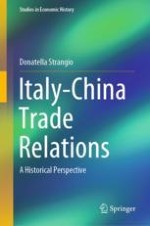2020 | OriginalPaper | Buchkapitel
4. Italy in China: 1861–1919
verfasst von : Donatella Strangio
Erschienen in: Italy-China Trade Relations
Aktivieren Sie unsere intelligente Suche, um passende Fachinhalte oder Patente zu finden.
Wählen Sie Textabschnitte aus um mit Künstlicher Intelligenz passenden Patente zu finden. powered by
Markieren Sie Textabschnitte, um KI-gestützt weitere passende Inhalte zu finden. powered by
